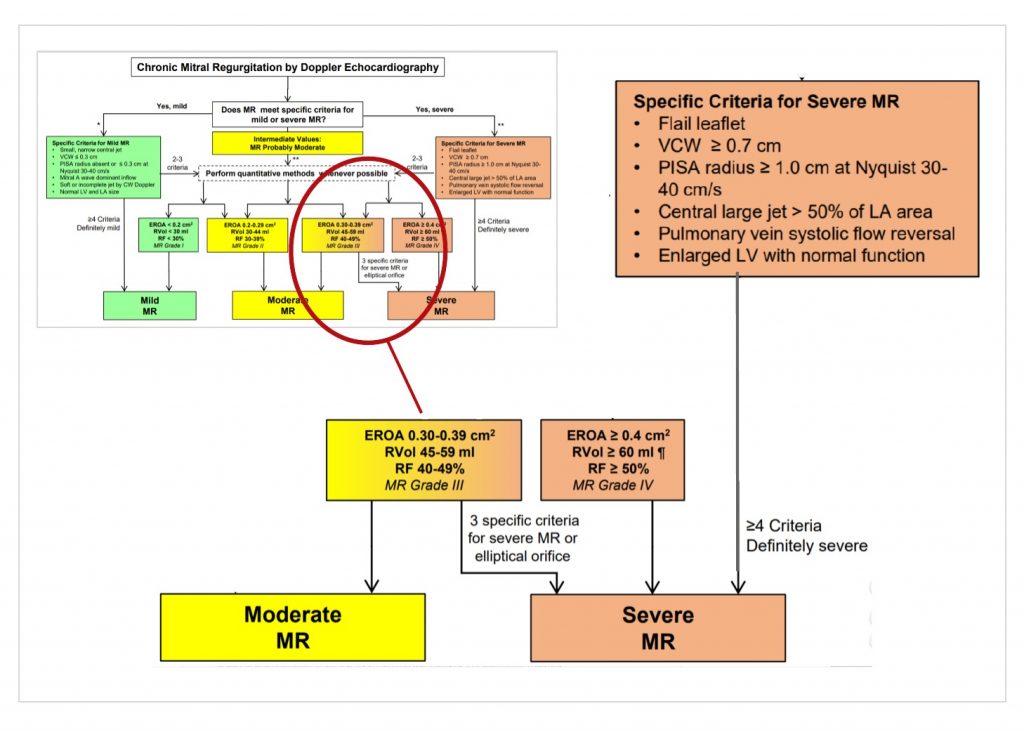We recently received a question from one of our readers regarding grading MR severity with echo. The question was, “Are any labs still using stage I-IV for grading mitral regurgitation? I still see some reports using this grading system. Is there a recommendation from ASE?”
The American Society of Echocardiography (ASE) released a valvular regurgitation guideline paper in 2017. Although we now categorize MR as either mild, moderate, or severe “quantitation of regurgitation can further subclassify regurgitation into four grades, with grade III having some overlap with characteristics of severe MR, hence the need for an integrative approach” (p.333)

Many people find the quantification algorithm from the ASE guideline paper daunting. Bear with me as I break down Grade III MR. The key to determining if grade III MR is classified as moderate or severe MR is based on specific criteria for severe MR.

The quantification algorithm starts by seeing if we can quickly rule-out mild or severe MR. For MR to meet the criteria of severe, without the need for additional advanced quantification, four or more specific criteria must be met.
If you do not meet four or more (>4) of these criteria, it will be necessary to calculate the EROA, RVol, and RF. You will note that Grade III MR values lead to two pathways of either moderate or severe MR. Both the moderate and severe pathways share the same quantitative values (EROA, RVol, and RF%). So why two pathways?

The assessment of MR severity requires an integrated approach incorporating advanced quantification measurements, specific severe criteria, and MR mechanisms. The category of “Grade III” MR is based on quantitative values (EROA, RVol, RF%) but the severity of Grade III MR is influenced by the number of specific severe criteria and the MR orifice shape.

There are many qualitative and semi-quantitative signs that help indicate the severity of MR with some of these signs considered specific for severe MR. So specific, that if 4 or more of these set criteria are met then the MR is “definitely severe” (ASE, 2017, p332).

When three (3) specific severe criteria are met, in the presence of Grade III MR values, the regurgitation is considered severe.
An easy way to remember this is:

Primary MR
Secondary MR
Grade III MR with either 3 specific severe criteria or with an elliptical shaped orifice is severe MR. The red elliptical border can add as a reminder!

Many people consider Grade III MR to mean moderate-to-severe MR. Moderate-to-Severe implies a spectrum. The ASE MR Quantification Algorithm provides a scale to determine where on the spectrum of severity MR lies when all factors are integrated into the diagnosis process.
If Grade III moderate MR is called moderate-severe MR that is probably not a big deal. But if Grade III secondary MR is called moderate-severe it will continue to under estimate secondary MR because most secondary MR have elliptical-shaped orifices.
Therefore, reporting grade III MR would require an additional statement on severity. For example, ‘Grade III Moderate MR’ or ‘Grade III Severe MR’.

Grading MR Severity with Echo requires a severity statement (mild, moderate, severe) A sub-category statement using grade I – IV may also be used. Since many doctors are familiar with using the numbered grading scale it will be necessary to state if grade III MR is moderate or severe.
Thank you for your question. To all of our readers…don’t be shy about asking questions! We are here to serve you and provide the resources you need to improve your understanding of echo techniques.
American Society of Echocardiography (ASE). April 2017. Noninvasive Evaluation of Native Valvular Regurgitation. https://www.asecho.org/wp-content/uploads/2017/04/2017VavularRegurgitationGuideline.pdf



